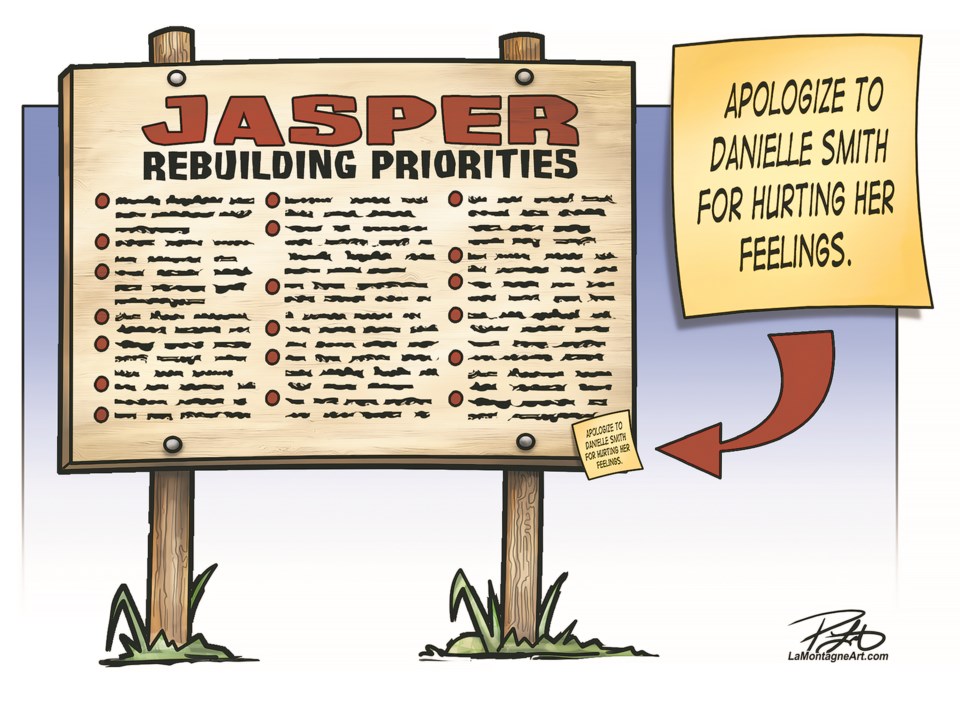There continues to be lessons to be learned a year after the Jasper wildfire.
As July 24 marks the first anniversary of the wildfire that destroyed one-third of the community’s buildings and engulfed about 33,000 hectares of Jasper National Park, it’s important to understand what can and should be improved on existing processes.
An after-action report commissioned by the Municipality of Jasper has triggered the provincial government, with the report stating provincial officials, at times, interfered with work from Parks Canada and local firefighters.
About 300 people were interviewed such as firefighters and emergency personnel, taking several months to complete. It largely stated that the overall response from all involved – which had all three levels of government have a role – was a success.
However, it also identified areas of concern and failure, with potential fixes to pursue.
When something goes wrong, it’s an invaluable lesson for all involved to go back, analyze what went right and what went wrong and apply those lessons for future scenarios. It’s called learning and improving on processes.
Though Premier Danielle Smith took it as a shot across the UCP’s bow – demanding the Municipality of Jasper withdraw support for the report and apologize – Jasper Mayor Richard Ireland emphasized it’s an independent report and not meant to be politicized.
While Jasper is a national park and under federal jurisdiction, the report highlighted the provincial government continually asked “to exercise decision-making authority” and the jurisdictional infighting “created political challenges that disrupted the focus of incident commanders.”
When such aspects are highlighted, it can be easy to get defensive but it’s vitally important to calmly reflect and understand what is being recommended and what can and should be implemented moving forward.
The constant battle and antagonism from the UCP provincial government against the federal Liberals knows no bounds, with the report the latest opportunity to pick a fight where none is needed.
The aftermath of the wildfire – which had about 25,000 residents and visitors evacuated – should focus on the improvement of processes rather than demanding apologies from a community where wounds are still fresh.
The after-action report is largely complimentary to the work that went underway during and the days after it spread into Jasper and the work done by all involved to slow and stop its spread.
The quick move to evacuate was safe and no human life was lost. Items ranging from homes, heirlooms, vehicles, laptops and many more were lost or left behind, but all can be replaced in time.
Work to implement some of the recommendations is underway such as having an on-staff psychologist to help Jasper firefighters with mental health support; Parks Canada and the Municipality of Jasper are working on additional fire prevention efforts and a 60-hectare area of land outside the townsite is now a fire buffer zone.
Though several hours away, the impact of the wildfire continues to linger in the Bow Valley. The immediate aftermath raised fears for many residents that a similar wildfire could take place locally. In the 12 months since, it has also spurred additional work by neighbourhoods and all three levels of government.
Throughout the Bow Valley, the priority for fireguards has gone into overdrive.
Though the municipalities have long pushed for more funding and work, the addition of provincial and federal resources has helped further mitigate the region against wildfire.
Extensive work has taken place in and around Canmore and Harvie Heights, but also in Banff National Park and areas of Kananaskis Country. Much more is set to be completed in the coming years.
Neighbourhoods have also played a key role such as Peaks of Grassi in Canmore and Middle Springs in Banff to mitigate the residential areas.
More than a year later, Jasper continues to be rebuilt. The work will likely take several more years, but the impact on the community will be generational.
The devastation the wildfire brought to the area will continue to be felt for decades, but the lessons learned will hopefully last far longer.




